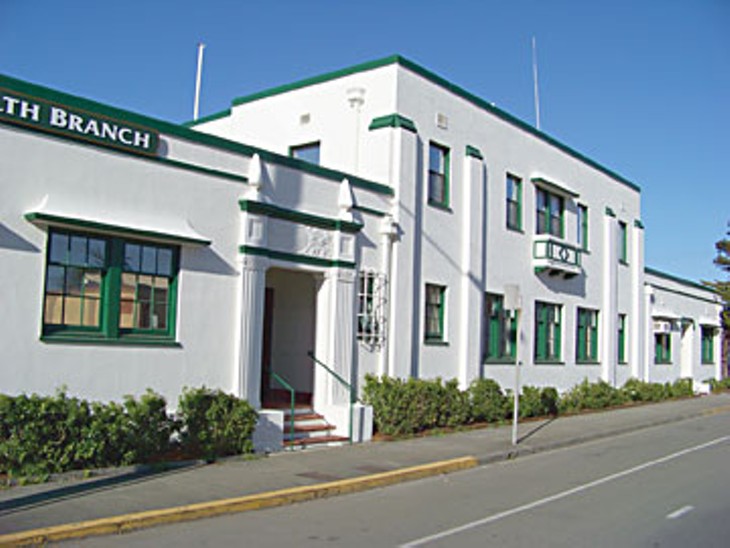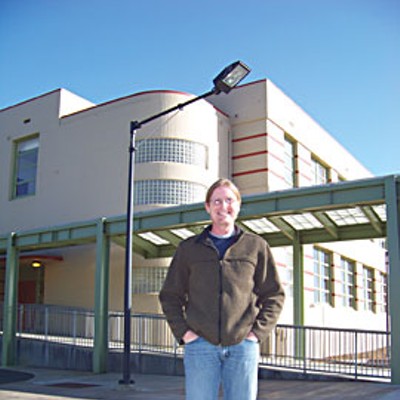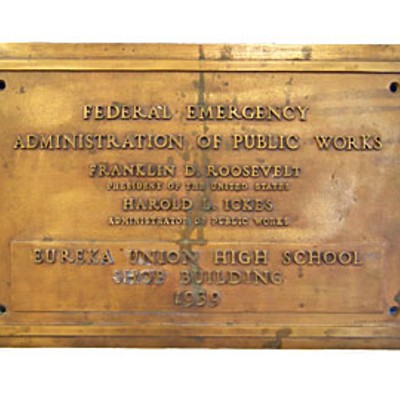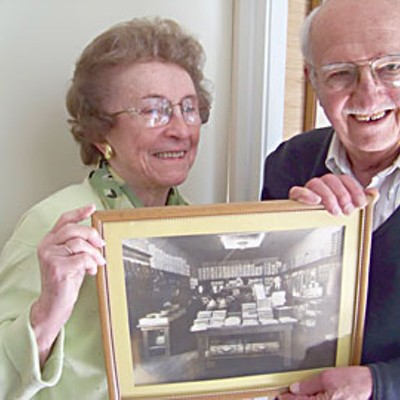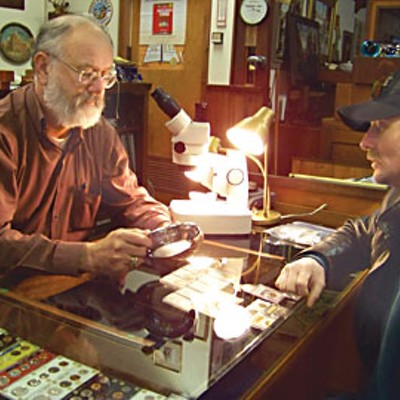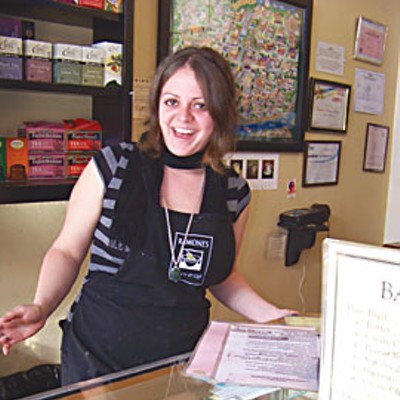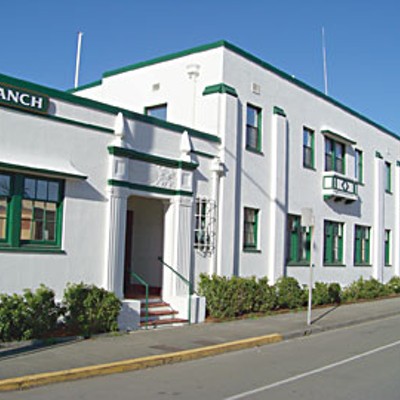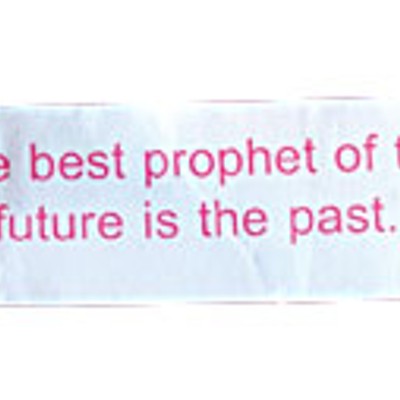Humboldt Depression
The 1930s were worse. Things are pretty bad now. But there's always chickens, berries and the family jewels.
By Heidi Walters[
{
"name": "Top Stories Video Pair",
"insertPoint": "7",
"component": "17087298",
"parentWrapperClass": "fdn-ads-inline-content-block",
"requiredCountToDisplay": "1"
}
]
Clomp clomp clomp clomp. I look around guiltily. It's one of those warm, half-sunny weekend days about to turn gray and wet, and lots of people are outside in my Eureka neighborhood, walking dogs and playing tennis or just sitting on the porch drinking in air soaked with the scent of plum tree blossoms. My new boots are too loud; they leave a trail of sidewalk echoes yammering about frivolous spending.
Hundreds of people out of work in this county, and here I've got me some new boots. Lumber mills shut down. Pulp mill on indefinite hold. Eureka Reporter -- my fellow newspeople! -- kaput. Stores and restaurants and auto shops -- oh, that's bad, too: I ordered these boots online, from somewhere far away. True, it is the first time I've done that; usually I "buy local." And, you know, they were on sale. And I didn't use a credit card. And a gift certificate paid for half of them. And nobody sells this particular boot here.
But did I need them?
Part of my guilt, admittedly, is from the pleasure that the online ordering rendered. Aside from agonizing over the ridiculous abundance of choices, it was so easy: a few mouse clicks, a debit card number, and next afternoon the beautiful boots are on my doorstep. Hey, I'm keeping the delivery folks busy. And my boots came in two cardboard boxes -- pulp, anyone?
Ah, hell. Guilt, counter-guilt. Thing is, more than just to indulge in a parade of vain paranoia and useless self-flagellation, I'm actually walking around out here on a mission. I'm searching for sidewalks and buildings with the mark of the WPA. In the mid-1930s, in response to the Great Depression, President Roosevelt's New Deal began putting the masses of unemployed people back to work through such entities as the federal Works Progress Administration and the Civilian Conservation Corps. They built roads and bridges, public buildings, park facilities and trails, sidewalks.
And since everyone's talking about the Great Depression these days and wondering how our hard times compare to those hard times, I've been wondering about it too. How did Humboldt County people weather the Great Depression? And, for that matter, how are Humboldtians reacting to the present economic crisis?
^^^^^
A recession, the experts are calling it, and a far cry yet from the Great Depression when unemployment soared over 25 percent nationwide. In an address at the Brookings Institution in Washington, D.C. two Mondays ago, Great Depression scholar Christina Romer, nominated by President Obama to lead his council of economic advisors, called the current nationwide unemployment rate of 8.1 percent "a terrible number that signifies a devastating tragedy for millions of American families." But she noted that there are far more social safety nets for people today than in the past. She noted some similarities in the causes of the Great Depression and the present economic situation: decline in the value of assets, shattered consumer confidence, bank failures (nearly half failed in America during the Great Depression, said Romer, vastly more than have conked today), a large drop in wealth, credit freeze, bankruptcy, more people refusing to spend. And it was worldwide. But Romer declared big differences between how FDR's administration dealt with the Depression -- small (though welcome) measures for a gargantuan problem -- and how Obama's is dealing with our recession. Today's $800 billion American Recovery and Reinvestment Act, Romer said, "is simply the biggest and boldest countercyclical fiscal action in history."
Still, nothing to be sneezed at, FDR's measures -- along with, in California, a host of state relief projects -- did give a lot of people jobs, and perhaps more important, hope. And Humboldt County, which some historians conclude wasn't as hard hit by the Depression because of its isolating geography and small population, had its share of hard times and government relief.
Eureka High School history teacher Craig Parker lately has been teaching the era in one of his classes. It's a subject dear to Parker's heart: In 2005, he did his master's thesis at Humboldt State University on how the Great Depression and, in particular, the New Deal played out in Eureka.
What Parker unearthed in his research laid out a mixed scenario: Humboldt County saw 16 of the 20 mills operating in the Eureka/Humboldt Bay region close between 1920 and 1939. And yet overall, between 1930 and 1940, employment "held steady," according to Parker's gleaning of Polk's Statistical Reviews (of course, newspaper accounts from the time record the yearly fluctuations and nuances). There were bread lines, and at least one hobo camp down near the waterfront. According to Polk's and other sources, wrote Parker, Eureka's population between 1930 and 1940 increased by about 13 percent (from 15,752 to 17,825), the city's assets decreased in value by about 10 percent, bonded debt increased nearly 22 percent, the three banks stayed solvent but their deposits decreased about 8 percent, there were more building permits (though their costs decreased) and more projects, and "the tax rate increased from $1.80 to $1.92 mill." Parker also discovered that Eureka's library used its Carnegie grant during that decade to pump up its volumes by more than 68 percent.
Public school enrollment in Eureka, he found, increased by 12 percent and schools overflowed with kids. That precipitated a $305,000 bond initiative to build four elementary schools and a shop building for the high school -- the Industrial Arts building, still in use today -- which, when passed, was matched 45 percent by the federal Public Works Administration. Public relief was evident in other ways in Humboldt, such as the CCC's construction of trails and facilities in parks like Prairie Creek and Patrick's Point, the food gardens for locally needy, planted in Eureka and at Indianola, that were jointly run by state relief-funded workers and young people put to work by the National Youth Administration, flour shipments for the poor, and more.
As part of the lesson, Parker has had his students write letters to Pres. Obama suggesting ideas for New Deal-type projects for today.
"A lot of them want programs similar to the CCC's, building new trails -- only they want new trails for quads [off-highway vehicles]," Parker said last week, in an interview in his classroom after school. He has a poster of FDR and Eleanor on a wall, and the original, heavy bronze plaque from the campus' Industrial Arts building propped against a blackboard. The plaque's awaiting reattachment to the building, Parker said. "Another idea was a Skateboard Corps that would go around the country building skateboard parks. Some students thought of murals, but putting them on the Web, on YouTube, so everyone could see them -- so, using new technology. I had a student who wanted an alternative energy program. And some students were very practical -- they want Obama to create some construction jobs."
Parker said some kids were inspired by his tale of the federal soil conservation program back in the Depression which, aiming to prevent another Dust Bowl, got farmers to stop growing soil-depleting crops like cotton and instead plant legumes. "And, this being Humboldt County, they said, 'Why not grow pot?'"
"The kids get it," Parker added. "They like the New Deal, they like the idea of solutions."
And even though his students also get that the Great Depression was worse than things are right now, they're not immune to today's recession. Humboldt's pretty bad off, with its latest unemployment rate clocking in at 11.1 percent -- and counties around it showing even higher rates -- its persistent decline in the traditional industries, its dropping school enrollments, its school budget cuts. Certainly, economists tell us, the county's more diversified than it was in the 1930s, which puts it in a better position to handle a downturn. And it has social services.
But Parkers' students are a little worried.
"The kids that are going off to college are a little concerned about dollars and cents -- are they going to get their financial aid, are they going to be able to afford it?" said Parker. "And also we have kids whose parents own small businesses in the community, and they're very concerned about it. They're concerned because they perceive, listening to their parents talk, that there may be increased taxes and maybe mom and dad won't be able to keep the store open. Other kids have parents with small businesses who've laid off everyone and now it's just mom or dad. And unfortunately, I had one young woman who left school because she had to support her mom."
Personally, however, Parker said he feels optimistic. "These last eight years, we got really jaded," he said. "And it pushed us all to the edge and we got fed up. With the new administration -- it's like when FDR was elected, and there was new hope."
^^^^^
It's getting harder to find people still living who were adults during the Great Depression. But there are plenty of people around who were children -- although they likely might not recall in detail things like unemployment figures and work programs and bond initiatives.
One day last week, Jeanne Nash and her brother Donn Johnson gathered at Nash and her husband Dick's home to talk about that time. Nash was born in 1922, Johnson in 1925, and they grew up on the corner of 14th and H streets in Eureka. They both remembered riding to Sequoia Park on the street car -- which in the Depression was just years away from being mothballed as the automobile took over. And they remembered that, on their block anyway, they were more fortunate than some in town, but not entirely impervious to the hard times.
"I know that by the end of the month, we'd be down to the last of the hamburger and my mother would say, 'It's just going to be soup for the next few days,'" said Nash.
Their father, Arthur Johnson, ran a men's clothing store of the same name successfully through the Depression (and the family kept it going until 1995), unlike some store owners who failed to meet rent and closed.
"My father was really, really tight," said Nash. "He was a cash man, he saved his money before he bought anything."
But her father did talk about the business around the dinner table at night, she said, and worried aloud sometimes whether he'd make it to the end of the month. He taught his kids how to handle their allowance, making them write down every penny spent or saved in a notebook. And he put them to work at the family store. "I started working there when I was 10 years old," said Johnson.
Nash and Johnson also remembered the men who'd come to their back door during the lean years, and how their mother would give the men food to eat outside on the porch.
Don Cloney (of Cloney's Pharmacy) also remembers those men. He grew up on the same block as the Johnson kids, and was 8 years old when the stock market crashed in 1929. His dad owned the Red Cross Pharmacy.
"My father didn't fail in business, but business was really tight," Cloney, over the telephone, recalled one day last week. "The economy depended upon the fishing industry and lumbering industry and hardly anything else. And the lumber mills were all closed and woods operations were all closed. Or if they were open they were not really doing anything."
He said kids for the most part couldn't really tell, amongst themselves, who was well off and who wasn't. "We all dressed the same and acted the same. ... the town was small, and in those times, a kid that was well off was a kid that had a bicycle. Everybody was living pretty close to the buck."
It cost a dime to go to the movies then, he said, although his parents didn't let him go very often. But movie-going was actually a big pastime. There was the Rialto, the Liberty, the State -- now the Arkley Center -- and, opened in 1939, the Eureka Theater.
Cloney said his family didn't suffer, except on his mother's side of the family. "My mother had three brothers that worked in the woods. They were loggers, and they had no work. They lived out around Hydesville, and they were all laid off. So they raised chickens and rabbits and pigs and berries and gardens and all of that, but they had no money. My mother and father helped them out. But I had girl cousins and boy cousins, and when the girls were graduating from 8th grade, well, they didn't have a nice dress. Things like that. They had all the basics, they had good food and they were always clean. But no luxuries."
Cloney said he remembered the droves of unemployed men, transients, down where the "Balloon Track" is today.
"A lot of hobos came up on the trains and they would camp in that area," he said. "They'd come up to the house, and my mom would feed them. She didn't bring them into the house -- we had a picnic table in the back, and she fed them there. Most of them were young men. Generally speaking, they were all nice and polite and semi-clean. They were traveling, seeing the country, carefree."
Even though he didn't suffer much in the Depression, Cloney said, the time marked him in a way younger people today might not quite understand.
"I have this built-in insecurity," he said. "I have a hangover from seeing people bad off. I never want to run out of money. I don't throw things away until they're used up. I don't buy things nickel-down. I'm not in debt. But I'm concerned about other people. My kids work hard and they're honest, but sometimes they look at you like, where did you come from? There's a big difference in attitudes today. Now, in the drug store business, people get medicine [through insurance] where they couldn't when I was a kid. My dad would sometimes let people have medicine on credit, but not a lot."
What really bothers him, though, are the stories he hears like the one about Battle Mountain, Nev. The other day he saw a TV program showing how, because the price of gold is so high now, that mining town is booming.
"And the people there are just living it up," Cloney said. "And yet, a hundred miles away from them, there are people without jobs. Can't they see it? That this get-rich-quick mentality isn't right? What we need is a society that lives sensibly."
^^^^^
I'm walking down toward Old Town now, taking the circuitous route: Along F Street to look at the WPA-built Municipal Auditorium. Then a jog over to the corner of 6th and I streets to see the charming, green-trimmed county public health branch building that the WPA built as a federal detention facility. And now over to the post office/federal courthouse, on whose top floor during the Depression a team of artists funded by the WPA painted murals depicting men hard at work in the traditional Humboldt County vein: mining, timber and agriculture; the murals are hard to view these days, their space now occupied by the off-limits local office of Homeland Security.
Something historian Ray Hillman had told me on the telephone recently, about Humboldt during the Great Depression, steers my boots over to a couple of antique shops on 4th Street. Hillman told me his dad was a Depression miner who left the poor job prospects of San Francisco in 1937 and headed north to try his hand at gold mining. A lot of men, in the late 1930s, poured north to Humboldt when they heard the mills were reopening -- according to news accounts, they so flooded the county's relief programs that meals for transients had to be cut in half. But Hillman's dad was going to the mountains in Trinity County. Like today, the price of gold was rising -- in 1932 it went from nearly $21 an ounce to $35 an ounce; the world was hoarding gold, pulling it out of banks, which exacerbated the crisis and led to Roosevelt's taking the country off the gold standard (paper bills backed by gold) to restructure the economy.
"My dad passed through Eureka on the way to the Trinity mines," Hillman had told me. "He was real independent and he wasn't about to stand in a bread line. So he and a couple of guys came up to Eureka and stayed overnight at a place on Broadway which was an auto camp, close to where Walgreens is today, and then they continued up Highway 299 the next day to what's called New River Country. It's part of the Trinity Alps Wilderness now."
Some of these Depression miners took pick and shovel to the rocks. Others, like his dad, worked the river gravels with a sluice box, looking for placer gold left behind by miners in the previous century. "But he found very little gold," said Hillman. "I know he taped a flake of gold that he found to a letter that he wrote to my mother -- they were to be married the next year -- and he wrote in there, 'You were right.' She'd had a lot of reservations about his running off to the mountains looking for gold."
Some miners in this "Second Gold Rush" even tried sifting the sands down near Clam Beach, Hillman said, to no avail -- it was too fine to collect. "It was so fine it would almost float."
On 4th Street, I stop in to talk to Bruce Pettit, owner of Heritage Antiques & Coins. With his trimmed fluffy white beard and wire-rimmed glasses, Pettit looks a bit like a cleaned-up prospector of old. He buys and sells gold, among other things, and these days, he tells me, traffic's really picked up.
"I have clients that are turning in what they call their 'worthless paper' for gold and silver," Pettit says. "Today [Friday, March 13], it's closing at $930 an ounce for gold and $12.40 for silver. So they're both high, so people are bringing in jewelry, and damaged stuff."
He in turn sells the gold and silver jewelry to refiners, and makes on average 10 to 15 percent out of the whole transaction.
As we're talking, a couple of men walk in. One of them, Thomas McLafferty, hands a silver-colored bowl and a couple of small coins to Pettit. He bought them at a yard sale, wants to know if they're worth anything. Pettit examines them. "Unfortunately," he announces after a time, "your bowl is not silver." The coins aren't viable, either.
It's close to closing time, and suddenly all kinds of people stream through the door with their treasures -- a blue velvet bag of foreign coins; an old-fashioned shaver. Some walk away with a few dollars, others emptyhanded.
Next door at Cody Gallery -- owned, I must disclose, by my friend Bill Cody -- it's a similar story. Cody deals in antiques, coins and other items. He's talking to customer Kathleen Regli, who's buying an orange glass vase. Regli, hearing I'm poking around about the Great Depression, says her great aunts and uncles lived through it, down in Loleta and Pepperwood. "They traded chickens for postage stamps and postage stamps for sugar," she says. "And they hoarded everything after the Great Depression -- you couldn't walk through the house because of all the stuff."
Like Pettit, Cody has noticed an increase in folks coming in with old gold jewelry and other gold scraps to sell -- dealing in gold has become a major part of business. Cody says he's also getting hordes of people down on their luck trying to sell him anything and everything. "It's kind of epidemic," he says. "They tell me they need money to buy diapers, to buy food, to pay their water bill. Some of it's junk. I mean, I've refused more than I buy. And there are charity cases, too, pleading -- like, 'Can you just help me out? I need a tire.'"
Sometimes people have decent stuff to trade or sell. Cody says he had a guy who came in recently with a couple of kids in tow. They'd lost their farm in Oregon because they couldn't afford it, and moved to Eureka. "They were living in the truck," he says. "He brought in some old pennies and a handful of coins, that he got $12 for -- enough for a meal and some sodas. But he also brought this painting, and asked me to look it up."
The painting looked like it might have been done by a student or an understudy of a painter back in the 1800s. "I gave him $100 and said, 'This is just to hold you over. If it winds up being something significant, we'll work it out.'"
But the painting turned out not to be by anyone famous.
^^^^^
At Ramone's, where I stop to buy the cheapest of the spendy espresso drinks and, in pathetic defiance of the times, a discount truffle, I find hope in a young woman who, it turns out, has actually been listening to her elders. Barista Sierra Anderson, 21, says she's noticed customers being more mindful of their choices these days, weighing their options and buying the lesser drinks and bargains. And she herself has quit going out so much.
"I used to be more free with my money," she says. "But I talk with older people, and they say to save it." So she does. She doesn't have a credit card. She has no debt. She bought her car with her own money. She doesn't make frivolous purchases.
I down my treats and head over to my bank -- probably shouldn't have bought these swell boots -- to check my balance. My bank: Several months ago it was taken over by another bank, which in turn may not be faring so well.
Waiting in line, I notice a trod-upon Chinese fortune on the concrete, the cookie long gone. Pick it up, smooth it out, read the red type: "The best prophet of the future is the past."
Indeed.
My balance, as I already know, is (barely) in the black. Well, it's never too late. And maybe things won't get so bad. Whether they do or not, I will wear these boots, I vow, ’til they disintegrate. And shop more sensibly. The thought makes me clomp clomp home a bit less sheepishly.
Comments (3)
Showing 1-3 of 3
more from the author
-
From the Journal Archives: When the Waters Rose in 1964
- Dec 26, 2019
-
Bigfoot Gets Real
- Feb 20, 2015
-
Lincoln's Hearse
- Feb 19, 2015
- More »
Latest in News
Readers also liked…
-
Through Mark Larson's Lens
A local photographer's favorite images of 2022 in Humboldt
- Jan 5, 2023
-
'To Celebrate Our Sovereignty'
Yurok Tribe to host gathering honoring 'ultimate river warrior' on the anniversary of the U.S. Supreme Court ruling that changed everything
- Jun 8, 2023
